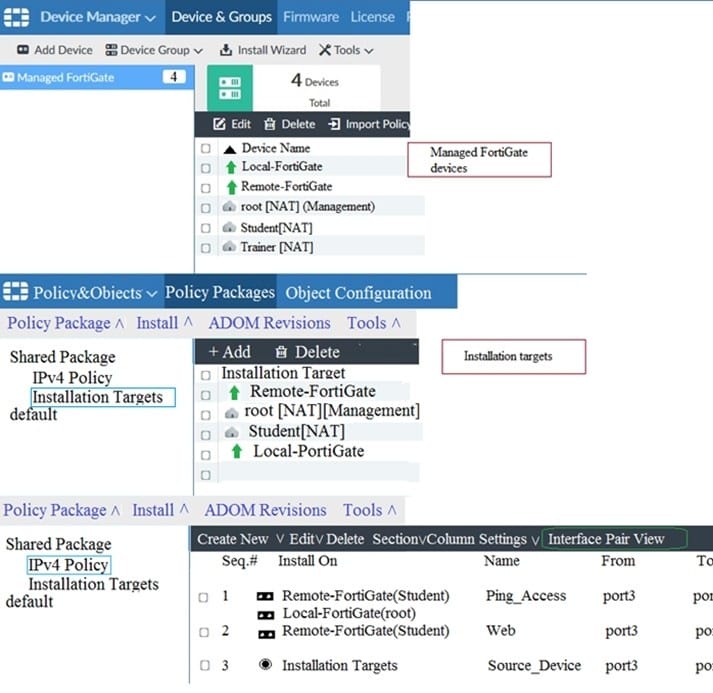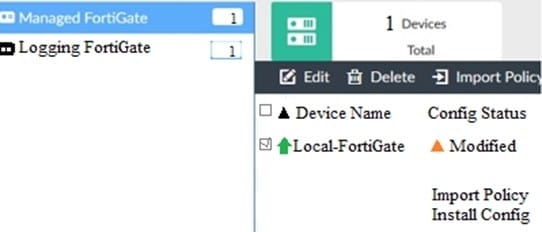NSE5_FMG-6.4 Online Practice Questions and Answers
Which two settings must be configured for SD-WAN Central Management? (Choose two.)
A. SD-WAN must be enabled on per-ADOM basis
B. You can create multiple SD-WAN interfaces per VDOM
C. When you configure an SD-WAN, you must specify at least two member interfaces.
D. The first step in creating an SD-WAN using FortiManager is to create two SD-WAN firewall policies.
What will happen if FortiAnalyzer features are enabled on FortiManager?
A. FortiManager will reboot
B. FortiManager will send the logging configuration to the managed devices so the managed devices will start sending logs to FortiManager
C. FortiManager will enable ADOMs automatically to collect logs from non-FortiGate devices
D. FortiManager can be used only as a logging device.
An administrator run the reload failure command: diagnose test deploymanager reload config
A. It downloads the latest configuration from the specified FortiGate and performs a reload operation on the device database.
B. It installs the latest configuration on the specified FortiGate and update the revision history database.
C. It compares and provides differences in configuration on FortiManager with the current running configuration of the specified FortiGate.
D. It installs the provisioning template configuration on the specified FortiGate.
What are two outcomes of ADOM revisions? (Choose two.)
A. ADOM revisions can significantly increase the size of the configuration backups.
B. ADOM revisions can save the current size of the whole ADOM
C. ADOM revisions can create System Checkpoints for the FortiManager configuration
D. ADOM revisions can save the current state of all policy packages and objects for an ADOM
What is the purpose of the Policy Check feature on FortiManager?
A. To find and provide recommendation to combine multiple separate policy packages into one common policy package
B. To find and merge duplicate policies in the policy package
C. To find and provide recommendation for optimizing policies in a policy package
D. To find and delete disabled firewall policies in the policy package
An administrator has assigned a global policy package to a new ADOM called ADOM1. What will happen if the administrator tries to create a new policy package in ADOM1?
A. When creating a new policy package, the administrator can select the option to assign the global policy package to the new policy package
B. When a new policy package is created, the administrator needs to reapply the global policy package to ADOM1.
C. When a new policy package is created, the administrator must assign the global policy package from the global ADOM.
D. When the new policy package is created, FortiManager automatically assigns the global policy package to the new policy package.
View the following exhibit.

Given the configurations shown in the exhibit, what can you conclude from the installation targets in the Install On column?
A. The Install On column value represents successful installation on the managed devices
B. Policy seq#3 will be installed on all managed devices and VDOMs that are listed under Installation Targets
C. Policy seq#3 will be installed on the Trainer[NAT] VDOM only
D. Policy seq#3 will be not installed on any managed device
Which two statements regarding device management on FortiManager are true? (Choose two.)
A. FortiGate devices in HA cluster devices are counted as a single device.
B. FortiGate in transparent mode configurations are not counted toward the device count on FortiManager.
C. FortiGate devices in an HA cluster that has five VDOMs are counted as five separate devices.
D. The maximum number of managed devices for each ADOM is 500.
Refer to the exhibit.

An administrator has configured the command shown in the exhibit on FortiManager. A configuration change has been installed from FortiManager to the managed FortiGate that causes the FGFM tunnel to go down for more than 15 minutes.
What is the purpose of this command?
A. It allows FortiGate to unset central management settings.
B. It allows FortiGate to reboot and recover the previous configuration from its configuration file.
C. It allows the FortiManager to revert and install a previous configuration revision on the managed FortiGate.
D. It allows FortiGate to reboot and restore a previously working firmware image.
Refer to the exhibit.

Given the configuration shown in the exhibit, which two statements are true? (Choose two.)
A. It allows two or more administrators to make configuration changes at the same time, in the same
ADOM.
B. It disables concurrent read-write access to an ADOM.
C. It allows the same administrator to lock more than one ADOM at the same time.
D. It is used to validate administrator login attempts through external servers.
What will be the result of reverting to a previous revision version in the revision history?
A. It will install configuration changes to managed device automatically
B. It will tag the device settings status as Auto-Update
C. It will generate a new version ID and remove all other revision history versions
D. It will modify the device-level database
An administrator has assigned a global policy package to custom ADOM1. Then the administrator creates a new policy package, Fortinet, in the custom ADOM1.
Which statement about the global policy package assignment to the newly-created policy package Fortinet is true?
A. When a new policy package is created, it automatically assigns the global policies to the new package.
B. When a new policy package is created, you need to assign the global policy package from the global ADOM.
C. When a new policy package is created, you need to reapply the global policy package to the ADOM.
D. When a new policy package is created, you can select the option to assign the global policies to the new package.
What is the purpose of ADOM revisions?
A. To create System Checkpoints for the FortiManager configuration.
B. To save the current state of the whole ADOM.
C. To save the current state of all policy packages and objects for an ADOM.
D. To revert individual policy packages and device-level settings for a managed FortiGate by reverting to a specific ADOM revision
What does a policy package status of Conflict indicate?
A. The policy package reports inconsistencies and conflicts during a Policy Consistency Check.
B. The policy package does not have a FortiGate as the installation target.
C. The policy package configuration has been changed on both FortiManager and the managed device independently.
D. The policy configuration has never been imported after a device was registered on FortiManager.
View the following exhibit.

When using Install Config option to install configuration changes to managed FortiGate, which of the following statements are true? (Choose two.)
A. Once initiated, the install process cannot be canceled and changes will be installed on the managed device
B. Will not create new revision in the revision history
C. Installs device-level changes to FortiGate without launching the Install Wizard
D. Provides the option to preview configuration changes prior to installing them
